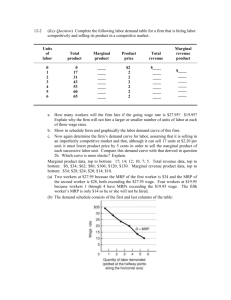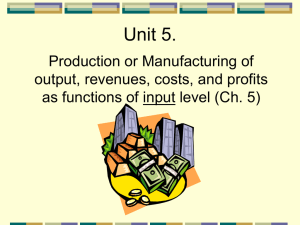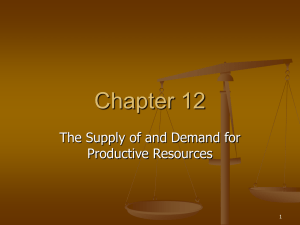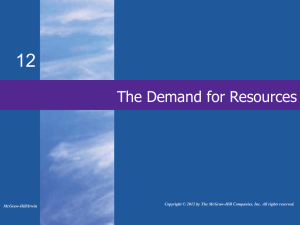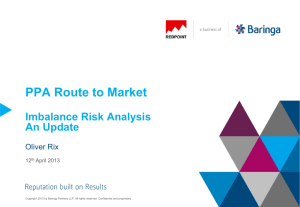Sports Economics May 4500 Chapter 7
advertisement
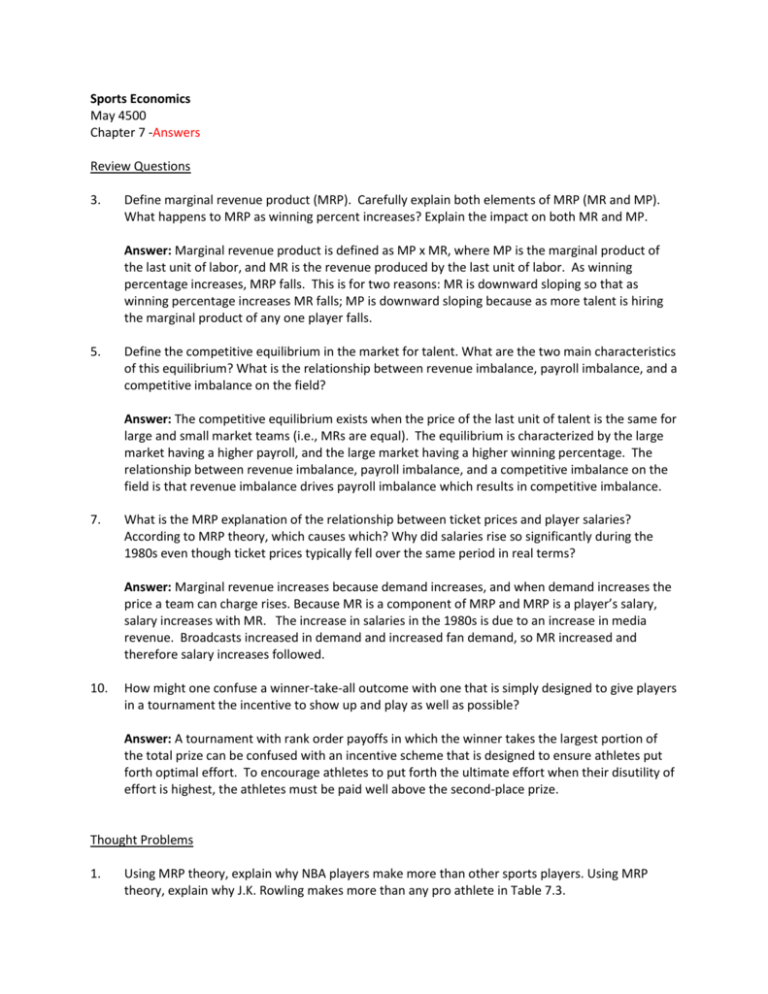
Sports Economics May 4500 Chapter 7 -Answers Review Questions 3. Define marginal revenue product (MRP). Carefully explain both elements of MRP (MR and MP). What happens to MRP as winning percent increases? Explain the impact on both MR and MP. Answer: Marginal revenue product is defined as MP x MR, where MP is the marginal product of the last unit of labor, and MR is the revenue produced by the last unit of labor. As winning percentage increases, MRP falls. This is for two reasons: MR is downward sloping so that as winning percentage increases MR falls; MP is downward sloping because as more talent is hiring the marginal product of any one player falls. 5. Define the competitive equilibrium in the market for talent. What are the two main characteristics of this equilibrium? What is the relationship between revenue imbalance, payroll imbalance, and a competitive imbalance on the field? Answer: The competitive equilibrium exists when the price of the last unit of talent is the same for large and small market teams (i.e., MRs are equal). The equilibrium is characterized by the large market having a higher payroll, and the large market having a higher winning percentage. The relationship between revenue imbalance, payroll imbalance, and a competitive imbalance on the field is that revenue imbalance drives payroll imbalance which results in competitive imbalance. 7. What is the MRP explanation of the relationship between ticket prices and player salaries? According to MRP theory, which causes which? Why did salaries rise so significantly during the 1980s even though ticket prices typically fell over the same period in real terms? Answer: Marginal revenue increases because demand increases, and when demand increases the price a team can charge rises. Because MR is a component of MRP and MRP is a player’s salary, salary increases with MR. The increase in salaries in the 1980s is due to an increase in media revenue. Broadcasts increased in demand and increased fan demand, so MR increased and therefore salary increases followed. 10. How might one confuse a winner-take-all outcome with one that is simply designed to give players in a tournament the incentive to show up and play as well as possible? Answer: A tournament with rank order payoffs in which the winner takes the largest portion of the total prize can be confused with an incentive scheme that is designed to ensure athletes put forth optimal effort. To encourage athletes to put forth the ultimate effort when their disutility of effort is highest, the athletes must be paid well above the second-place prize. Thought Problems 1. Using MRP theory, explain why NBA players make more than other sports players. Using MRP theory, explain why J.K. Rowling makes more than any pro athlete in Table 7.3. Answer: MRP = MP x MR. Either NBA players have higher MP or higher MR or both, compared to players in other leagues. With only a dozen or so players on the entire roster, it is possible that any given player's MP is larger. In addition, noting NBA ticket prices, it appears that fans pay more for the talent they enjoy. For J.K. Rowling the same type of analysis holds- the contribution may be an approximation of MP and the willingness of readers to pay for production helps determine the MR portion. 4. In our example in Table 7.4 and Figure 7.1, Randy Johnson won 20 games with a terrific earned run average in 1997. He was paid about $7.5 million. In 2001, he had nearly an identical season to 1997 but earned almost twice as much. Does this violate MRP theory? Why or why not? Answer: MRP=MP x MR. Performance focuses only on the MP part of MRP. That raises two issues. First, even though performance may not improve, the market for pitchers also matters; perhaps pitching in general has taken a turn for the worse, league-wide. In such a case, Johnson's MP is not unusual. Second, the willingness to pay by fans for the contribution that Johnson does make, even if unchanged, can increase over time. While it seems paradoxical, pitchers that get a bit worse over time actually can be worth more over time if demand for their services, derived from fan willingness to pay, increases anyway. Finally, recognize that Johnson was on different teams. Willingness to pay for a given record in Seattle can be lower than willingness to pay for the same record in Arizona. 5. Observers of pro sports leagues have lamented over competitive imbalance in one league or another at different points in time. Without exception, these observers point to payroll imbalance as the culprit. Correct them or agree with them, and justify your correction or agreement. Answer: From the theory and Figure 7-2, we can determine that the chain of causation is as follows. Exclusive territories lead to revenue imbalances between teams- owners in large-revenue markets must provide much higher quality at much higher cost than owners in small-revenue markets. In this way, revenue imbalance leads to payroll imbalance. In turn, the competitive imbalance dictated by the fans in exclusive territories is created. It is not payroll imbalance, per se, that is the culprit in competitive imbalance outcomes. At the heart of the issue is the maintenance of exclusive territories generating different revenues for owners.
